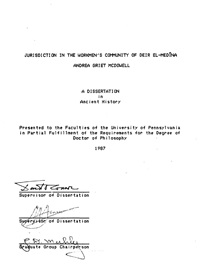| Main » Ad Board » ДРЕВЕН ЕГИПЕТ И АФРИКА » Бит и ежедневие |
| 08.06.2022, 05:43 | |
Дисертацията разглежда детайлно различните съдебни органи, под чиято юрисдикция са жителите на работническото селище Деир ел Медина, обслужващо Тиванския некропол. Оказва се, че те са поне няколко и образуват сложна система от компетенции и взаимодействия, като нерядко делата и споровете се прехвърлят от една институция на друга, а желанието на страните в един спор не винаги е водещ момент. АЛТЕРНАТИВЕН ЛИНК / ALTERNATIVE LINK: - на английски език, от Google Drive, формат PDF. Сваляне с ляв бутон (downloading by left button) от страницата на предоставящия сървър, после през бутона стрелка надолу/after by down arrow button.
| |
| Views: 650 | Placed till: 08.07.2022 | Rating: 0.0/0 | |

